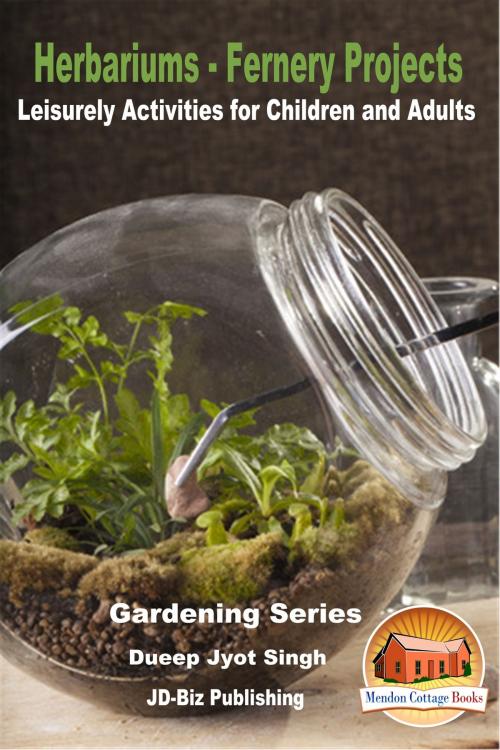Herbariums: Fernery Projects - Leisurely Activities for Children and Adults
Nonfiction, Home & Garden, Gardening, Reference| Author: | Dueep Jyot Singh | ISBN: | 9781370122080 |
| Publisher: | Mendon Cottage Books | Publication: | September 11, 2016 |
| Imprint: | Smashwords Edition | Language: | English |
| Author: | Dueep Jyot Singh |
| ISBN: | 9781370122080 |
| Publisher: | Mendon Cottage Books |
| Publication: | September 11, 2016 |
| Imprint: | Smashwords Edition |
| Language: | English |
Table of Contents
Introduction
Starting Your Herbarium
Butterflies and Insects Added to Your Pages
Adding Mosses to Your Herbarium
Making Your Own Fernery
Plant Choices
Conclusion
Author Bio
Publisher
Introduction
If you are interested in preserving plants, in the shape of dried flowers, leaves, and even seedpods, you may want to preserve them for posterity in what is known as a herbarium. In olden days, it was called a Hortus Siccus – and since ancient times, gardeners and botanists kept looking for ways and means in which they could preserve flowers, and plants in a dried condition, for a long time.
These herbariums were found in the East, where the Chinese knew how to manufacture paper, more than 3,000 years ago. These plants were placed between paper and pressed and dried. It was only when people in Europe got to know about paper, about 800 years ago, apart from using this for writing manuscripts, they also began to preserve plants between sheets of paper, especially when Linnaeus began his own way of classifying plants and so brought the science of taxonomy to the Latin speaking world of Western scholars.
And that is why the men went collecting, all over the globe, bringing back samples of flowers, leaves, and other parts of the plants, which they dried in wooden presses. If they were blessed with an artistic talent, they would do a little bit of painting of that sample, or records, but this painting and drawing was left to the women of the house because that was supposed to be an aristocratic talent, which the middle-class adopted in the 18th – 19th century.
When we were in College, getting ready to collect our Degrees in Science, we had to make a herbarium of which there were at least one or two plants, of which we had learned while studying the morphology, physiology, characteristics, and taxonomic characteristics of 75 families.
The Potato and the Crucifer family plants were easy to obtain, because that area was agriculture based and all we had to do was go to the nearest farm, gather a Solanaceae leaf and flower and a cruciferous healthy specimen of either mustard, or other Brassica family cruciferous plants.
But when it came to the mimosa – bottlebrush family, that poor little plant! There was just one bottlebrush tree in our college, and there were 275 students, in the science faculty, every year spanning over three years and nine Class Sections – First-Year, Second-Year, and Third-Year. And every student wanted a bottlebrush flower and leaf.
So we being really mean types, used to wait until our Final Year, and if we did not have any of the samples of the plants needed to complete our herbarium, we would commandeer the herbarium of a junior Frosh, doing unto them, what had been done unto us by our Seniors!
These herbariums where the culmination of three years of serious botanical study – 75 families in three years – and that is why, whenever I go for a ramble in the woods today, it is always a half reminiscent pensive, “Drat, here you are, blooming away so merrily, you silly plant, where were you when I needed you at College?”
Anyway, this herbarium is definitely not going to be made for academic reasons and for gaining lots and lots of marks and an A+, but just for fun.
Table of Contents
Introduction
Starting Your Herbarium
Butterflies and Insects Added to Your Pages
Adding Mosses to Your Herbarium
Making Your Own Fernery
Plant Choices
Conclusion
Author Bio
Publisher
Introduction
If you are interested in preserving plants, in the shape of dried flowers, leaves, and even seedpods, you may want to preserve them for posterity in what is known as a herbarium. In olden days, it was called a Hortus Siccus – and since ancient times, gardeners and botanists kept looking for ways and means in which they could preserve flowers, and plants in a dried condition, for a long time.
These herbariums were found in the East, where the Chinese knew how to manufacture paper, more than 3,000 years ago. These plants were placed between paper and pressed and dried. It was only when people in Europe got to know about paper, about 800 years ago, apart from using this for writing manuscripts, they also began to preserve plants between sheets of paper, especially when Linnaeus began his own way of classifying plants and so brought the science of taxonomy to the Latin speaking world of Western scholars.
And that is why the men went collecting, all over the globe, bringing back samples of flowers, leaves, and other parts of the plants, which they dried in wooden presses. If they were blessed with an artistic talent, they would do a little bit of painting of that sample, or records, but this painting and drawing was left to the women of the house because that was supposed to be an aristocratic talent, which the middle-class adopted in the 18th – 19th century.
When we were in College, getting ready to collect our Degrees in Science, we had to make a herbarium of which there were at least one or two plants, of which we had learned while studying the morphology, physiology, characteristics, and taxonomic characteristics of 75 families.
The Potato and the Crucifer family plants were easy to obtain, because that area was agriculture based and all we had to do was go to the nearest farm, gather a Solanaceae leaf and flower and a cruciferous healthy specimen of either mustard, or other Brassica family cruciferous plants.
But when it came to the mimosa – bottlebrush family, that poor little plant! There was just one bottlebrush tree in our college, and there were 275 students, in the science faculty, every year spanning over three years and nine Class Sections – First-Year, Second-Year, and Third-Year. And every student wanted a bottlebrush flower and leaf.
So we being really mean types, used to wait until our Final Year, and if we did not have any of the samples of the plants needed to complete our herbarium, we would commandeer the herbarium of a junior Frosh, doing unto them, what had been done unto us by our Seniors!
These herbariums where the culmination of three years of serious botanical study – 75 families in three years – and that is why, whenever I go for a ramble in the woods today, it is always a half reminiscent pensive, “Drat, here you are, blooming away so merrily, you silly plant, where were you when I needed you at College?”
Anyway, this herbarium is definitely not going to be made for academic reasons and for gaining lots and lots of marks and an A+, but just for fun.















